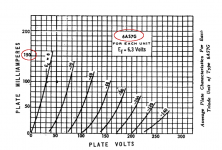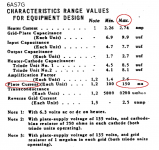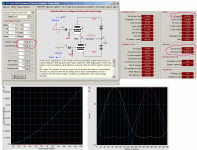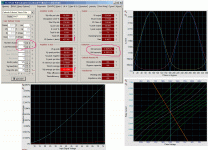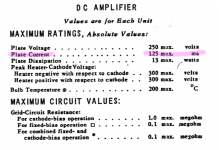You can get 20 watts out of a pair of 6AS7Gs if the load impedance is high enough. You'd need a 64 ohm load or thereabouts. Enough smaller speakers all in series in an array would work.
I run about 150 volts on the plates of the output tubes.
I use four 8" drivers in series to get 32 ohms for my 50-watt amp. I arranged the drivers in as a line source array (open back cabinet) so it projects really well.
I run about 150 volts on the plates of the output tubes.
I use four 8" drivers in series to get 32 ohms for my 50-watt amp. I arranged the drivers in as a line source array (open back cabinet) so it projects really well.
How does 50 watts sound in a combo, weighing less than a Fender twin and better able to project? That's with 4 power tubes and tubes don't weigh that much. The efficiency of an OTL depends entirely on the load and its not that hard to come up with a real world load that a smaller OTL can drive.
I use 6AS7Gs. They are weird but they're still cheap and apparently still in production (China).
Not much weight to be saved with OTL if more than 2 power tubes are needed. It's not just the weight of the added power tubes and their sockets but also the PSU. In general the bigger transformer is the PSU one. So if you really want to save weight you should think about switching power supply for the heaters and use PSU transformer only for anode and bias voltages.
The OPT of guitar amp doesn't need to be big as lowest frequency is 80Hz. An OPT designed to deliver (undistorted) 50W @80Hz is rather small in the 1-1.5Kg and you only need two 6L6's or EL34's. For 20W amp with 2xEL84's it's even smaller.....
Then there are other two ways to reduce weight:
1) A LOT of weight can be saved with the right choice of the "wood" of the cabinet...I have found a very light and stiff one.
2) Use small ALNICO or Neodymium magnets cones.
I can't seem to get your numbers to work.You can get 20 watts out of a pair of 6AS7Gs if the load impedance is high enough. You'd need a 64 ohm load or thereabouts.
It looks like 150 mA max current per triode (see attached datasheet grabs.)
Four tubes = 8 triodes, presumably four push-pull pairs, so maximum peak current for either half-cycle is 4x150 mA, or 600 mA (peak).
Maximum RMS current is therefore 600/(square root of 2) = 424 mA = 0.424 A.
Maximum power output into 64 ohms = Irms x Irms x 64 = 0.424 x 0.424 x 64 = 11.5 watts.
It would appear four of these twin-triode 6AS7G tubes, wired as four push-pull pairs, can only deliver 11 or 12 watts RMS into 64 ohms.
So it would seem that you'd need eight 6AS7G tubes to deliver 46 watts RMS, near enough to the 50 watts you mentioned.
Any idea why there's a 400% disagreement between my math and yours? Are you running the triodes to twice their rated maximum current (which will quadruple the output power)?
-Gnobuddy
Attachments
I Read at one gentleman, he give at this power tube ( 6AS7, ecc230, 6080) whit 350v, more much tensión, more big which the datasheet reference, it is posible a run normalized rule?
And whithout fire?
And it send to power at the 45w
I not know if this include or 2 of this tubes.
But 45watts ( included,whit transformer of 5k) is very much.
I more inclinate at use this to 150v or less, but good it is curiosity for my at 350v
And whithout fire?
And it send to power at the 45w
I not know if this include or 2 of this tubes.
But 45watts ( included,whit transformer of 5k) is very much.
I more inclinate at use this to 150v or less, but good it is curiosity for my at 350v
Last edited:
I can't seem to get your numbers to work.
It looks like 150 mA max current per triode
That's a DC limit.
Peak current can be higher. Especially on speech/music/guitar instead of steady test-tone.
I happened to have a 6080/6AS7 plan set up in TubeCad PPcalc. I don't think I hit the conditions you are discussing. I'm not totally sure I believe these numbers. I might be able to confirm them in hand-check, but too much work, not my amplifier. (Look at the total power consumption!!)
First eight pairs (8 bottles) into 64 Ohms. 47 Watts at low THD without any grid current. Plate current curves look reasonable. 176mA peak per plate is fine.
Second, eight pair into 8 Ohms. 60 Watts! 3%THD is nothing. Plate efficiency and total power sucked are atrocious. Plate dissipation is significantly exceeded; I would overlook this for unclipped speech/music but on overdriven guitar I would expect real poor tube life. I'm sure this can be some better with change of supply voltage. It still seems like an expensive way to avoid a transformer.
Attachments
Last edited:
For DC, the datasheet limit is even lower, at only 125 mA (see attached datasheet snippet.)That's a DC limit.
Eight output bottles? Now that reminds me of a solid-state audio power amp somebody made using dozens of BC148/158 small-signal transistors in parallel for each output device. Completely impractical, and done only for fun.First eight pairs (8 bottles)
It does, indeed!It still seems like an expensive way to avoid a transformer.
-Gnobuddy
Attachments
I exprime full power of only one 12k5, (35mw datasheers) at point of extract of this necesary volume for guitar play , whit sonic sensation to more or near of 1wat, whit 16 ohms and 102.8 db of the speaker. This amp for home and portatil use ( whithout batery) whit champ tipe box-tolex only 3,5 kg or less !!!!! An very very short influence of components and not coloreate the signal. And it is very good how audifone close amp, whit output direct real, not acoplate , not DC.
" My idea is similar, and more big rendimient in comparatión, for guitar play , but whit only one 6080/6AS7/ecc230, (or EL34), ( or two tubes maxime), and maximice the rendimient of this. This small idea Amp is more practical, small weigth, etc..."
I read in various sites, the inductance component whit ferro in anode or catode up more power in comparatión to resistence, it is real and practice?
All for the guitar world diversión
For not confuse the finality of all this, here ones singles sounds of how it is work whit diferent guitars types and models. For saturate sound whit only one guitar pedal in imput ( type Brownd sound in a box / BSIAB II)
Amplificadores - OTL Guitar Amp World --
Thanks.
" My idea is similar, and more big rendimient in comparatión, for guitar play , but whit only one 6080/6AS7/ecc230, (or EL34), ( or two tubes maxime), and maximice the rendimient of this. This small idea Amp is more practical, small weigth, etc..."
I read in various sites, the inductance component whit ferro in anode or catode up more power in comparatión to resistence, it is real and practice?
All for the guitar world diversión
For not confuse the finality of all this, here ones singles sounds of how it is work whit diferent guitars types and models. For saturate sound whit only one guitar pedal in imput ( type Brownd sound in a box / BSIAB II)
Amplificadores - OTL Guitar Amp World --
Thanks.
Last edited:
I've been building 60 watt amps using this tube, driving 8 ohms (and OTL) for over 30 years. They are quite reliable (we warrant the power tubes for a year, so they have to be reliable) and have no problems making 60 watts. They've done well in reviews of which there are quite a few and have also garnered awards in the high end audio press. TubeCAD notwithstanding.
However, the tube has linearity into grid current, so I make sure my driver circuit can run them class A2 (or AB2, depending on the loudspeaker load).
Now in the case of a guitar amp, no need to bias them as hard as I do in a high end audio situation. So they run fairly cool. But the driver can still drive them into grid current with good linearity.
I use toroid power transformers so the weight works out pretty well.
However, the tube has linearity into grid current, so I make sure my driver circuit can run them class A2 (or AB2, depending on the loudspeaker load).
Now in the case of a guitar amp, no need to bias them as hard as I do in a high end audio situation. So they run fairly cool. But the driver can still drive them into grid current with good linearity.
I use toroid power transformers so the weight works out pretty well.
For DC, the datasheet limit is even lower, at only 125 mA....
Ah, that is what was in my mind.
Your "150mA" is taken from expected current spread under certain conditions. Actually says "100mA-150mA", a reasonable spread on an important parameter.
These were designed and marketed as Pass Tubes, voltage regulators.
The 125mA rating is "steady all day". I was just reading an RCA TV-rack power supply, 275V 1,500mA, which would normally be left on and mostly loaded from before Dawn Sermon to after the Late Movie. (Most TV processing pulls a steady current.)
As atmasphere's experience shows, these tubes are sturdy and can *peak* far past their steady rating. It may take positive grid well. That was not normally done in Pass-Tube work; the tubes are designed to reach their steady all-day rating below zero-grid, because that simplifies the error amplifier design. But for the very spiky nature of speech/music it makes sense to beef the driver and drive the big tubes into grid current.
60 watt amps using this tube, driving 8 ohms (and OTL) for over 30 years.
So 3.9 A peak currents flowing on each half-cycle, if the speaker is nice and resistive and never drops below 8 ohms at any frequency (a very gentlemanly speaker indeed.)
How many 6AS7Gs did this take?
-Gnobuddy
I tortured some 6AS7GA's, 6080's, 6336's and several sweep tubes a few years ago when working on a cathode follower output stage. I can also state that they are quite capable of taking some abuse. If you keep the AVERAGE plate current in the 200 mA or less range AND the AVERAGE plate dissipation in the 13 watts per plate range (6080WB max), you can let the peaks run where they may without blowing anything.
For most HiFi use the idle current can be 50+ mA with peaks into the hundreds of mA, yet still average under 200 mA. Guitar amp use, or worse continuous sine wave testing will require some testing.
All of my testing was done with a 600 ohm OPT, never tried OTL which would involve much higher peak currents.
For most HiFi use the idle current can be 50+ mA with peaks into the hundreds of mA, yet still average under 200 mA. Guitar amp use, or worse continuous sine wave testing will require some testing.
All of my testing was done with a 600 ohm OPT, never tried OTL which would involve much higher peak currents.
Which makes technical sense given the current capabilities of the tubes you were using. 600 ohms is not too far from the original Phillips OTL amps with their special 800 ohm speakers.All of my testing was done with a 600 ohm OPT <snip>
Heck, if we had 2000 ohm speakers, even dinky little radio tubes like the 50C5 could play OTL tricks.
But a tube OTL amp with an 8 ohm speaker? That seems to have all the engineering synergy of a peanut-butter and shoe-polish sandwich.
-Gnobuddy
For 60 watts into 8 ohms, a total of 8 power tubes.So 3.9 A peak currents flowing on each half-cycle, if the speaker is nice and resistive and never drops below 8 ohms at any frequency (a very gentlemanly speaker indeed.)
How many 6AS7Gs did this take?
-Gnobuddy
Atma-Sphere
But a tube OTL amp with an 8 ohm speaker?
They exist, and reportedly sound good for HiFi, but I have never heard one, so what do I know.
Several years ago a friend gave me 3 X 5 HY 2.5 AMP! chokes. Together they weighed more than me, but I had this wild idea to make a monster SE OTL with a bunch of sweep tubes in parallel. I got as far as wiring up 12 sockets and warming up the room with about 200 watts of heater only power. The project remained dormant for years and was given away before I had to move everything 1200 miles.
This thread has given me another rather stupid idea, don't know yet if I will actually act on it. I have a pair of version 1 of these transformers. They have a more pronounced rolloff in the HF region than these, but would be OK for a guitar amp. It would be fairly simple to wire this up into a low parts count OTL guitar amp. I could stick this transformer in place of the OPT, then drive some parallel wired sweep tubes in a totem pole configuration off the secondary. I have some BIG isolation transformers with 4 X 120 volt windings for power, and 4 X 6 inch Eminence guitar speakers which could be wired in series.
I made some "booster" amps like this in the late 60's and early 70's, but their output devices were sand based life forms....the biggest one made about 1200 watts at the point where the line breaker blew.
Universal Interstage Transformer UIS-1 MADE IN USA
A friend of mine borrowed one of our M-50 amplifiers (immediate predecessor the M-60, linked above) and I found out he was using it as a power amp to drive his Marshall stack. It seemed to sound just fine; that is what drove me to build an OTL guitar amplifier years later.They exist, and reportedly sound good for HiFi, but I have never heard one, so what do I know.
The power amp section wasn't the problem- I made the preamp far too complex. I wanted enough gain for the kind of crunch you need for metal and didn't realize that such gain often comes from pedals.
In guitar is good idea one amp very good in clean and transparent/neutral, And it impulse the personal tone and pulsation of the guitar
The Otl is good for this purpose.
And saturate it whit some guitars pedal external. I use this for go the amp at various types of sounds ( fender, marshall, metal, soldano, bogner, mesa, etc..).
One good cleand song is the base, for my And can saturate this for multiple forms, by preamp, pedals( whit tubes include), ...
And can saturate this for multiple forms, by preamp, pedals( whit tubes include), ...
in this can see and compare of single form one bad pedal of one good, it is more single and positive for you election of pedal and saturatión, and all tubes in the final of the chain.
The Otl is good for this purpose.
And saturate it whit some guitars pedal external. I use this for go the amp at various types of sounds ( fender, marshall, metal, soldano, bogner, mesa, etc..).
One good cleand song is the base, for my
in this can see and compare of single form one bad pedal of one good, it is more single and positive for you election of pedal and saturatión, and all tubes in the final of the chain.
Last edited:
In guitar is good idea one amp very good in clean and transparent/neutral, And it impulse the personal tone and pulsation of the guitar
The Otl is good for this purpose.
The presence of proper output transformer is NOT going to prevent that either. Guaranteed. Actually it's easier to get.....
We've built a lot of guitar amps in our shop. Several of my employees build guitar amps which they play in their bands. None have come anywhere near the transparency of our OTL guitar amp; its much easier to hear the difference between a really good pickup and a cheap one, as well as the character of the guitar cable itself.The presence of proper output transformer is NOT going to prevent that either. Guaranteed. Actually it's easier to get.....
- Status
- Not open for further replies.
- Home
- Live Sound
- Instruments and Amps
- OTL amps for guitar duty
